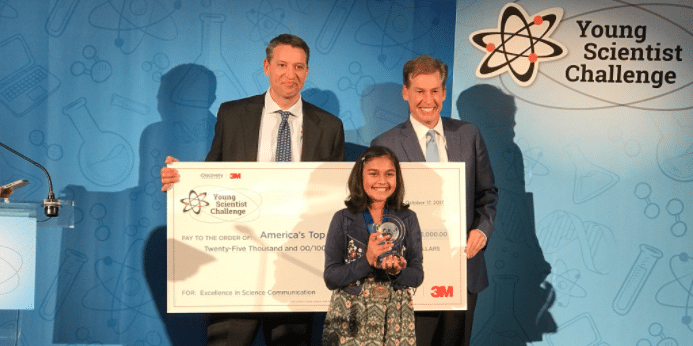NRI
11-Year-Old Gitanjali Rao Named America’s Top Young Scientist

Gitanjali Rao, a seventh-grade student, invented a quick and cheap lead contamination detector for water.
Gitanjali Rao, an 11-year-old Indian-American schoolgirl, was named as “America’s top young scientist” for inventing a cost-effective, quick lead-contamination detector in water. The seventh-grade student was inspired by the large-scale lead contamination in water in Flint, Michigan, that came to light recently.
The cost-cutting measures employed by Flint led to contaminated water becoming the primary source of water for many. Officials are facing manslaughter charges for allowing lead-contaminated water to be used in the water system in 2014-15.
Rao won $25,000 for taking the top position at the 2017 Discovery Education 3M Young Scientist Challenge. She was chosen from 10 finalists who had worked with scientists for three months to develop their ideas.
“The idea just came to me when I saw my parents testing for lead in our water,” Rao told Business Insider. “I went, ‘Well, this is not a reliable process and I’ve got to do something to change this’.”
The competition, which is held every year, asks children to invent a device that could solve everyday problems. The children then upload videos demonstrating their invention and 10 finalists are chosen.
Breaking news! 2017 America’s Top Young Scientist…Gitanjali Rao. #youngscientist #DiscoveryEd pic.twitter.com/SQr3O2FXcM
— scott_kinney (@scott_kinney) October 18, 2017
Rao’s device uses carbon nanotubes to detect lead contamination. Around 5,300 water systems in the United States are reportedly contaminated by lead.
“If you take a shower in contaminated water, you do get rashes and that can easily be studied by an epidemiologist,” Rao told Business Insider. “And if somebody drinks lead in their water, their children might have small, minor defects.”
The portable device, which she named Tethys after the Greek goddess of fresh water, allows a sensor linked to a mobile app to deliver accurate and quick analysis of the water sample. Earlier methods were expensive since the sample had to be sent to a lab for reliable testing.
The 11-year-old came upon the solution while browsing the website of the MIT Department of Materials Science and Engineering, she told ABC News. When she read an article on new technologies that could be used to detect hazardous substances, Rao decided to adapt it to detect lead. She sought the help of her parents, Bharathi Rao and Ram Rao, both engineers, her teachers and experts at local colleges.
“It’s not hyperbole to say she really blew us out of the water,” Dr. Brian Barnhart, an Illinois school superintendent and one of the seven 3M judges, told ABC News. “The other nine kids, they were also such amazing kids, so for her to stand out the way she did with a peer group like this is like an exclamation point on top of it.”
He added: “She is the kind of young person that we can all look forward to what she’s going to do for society.”
Rao wants to improve upon the device so that it could eventually be used by people. She aspires to become either a geneticist or epidemiologist when she grows up.
Among the projects submitted by the other nine finalists were a robot to help reduce water wastage during lawn maintenance, a biodegradable cleaning material for oil spills made from pomegranate husks and orange peel, and the identification of a molecule that could be used to treat Alzheimer’s disease.

7 Comments